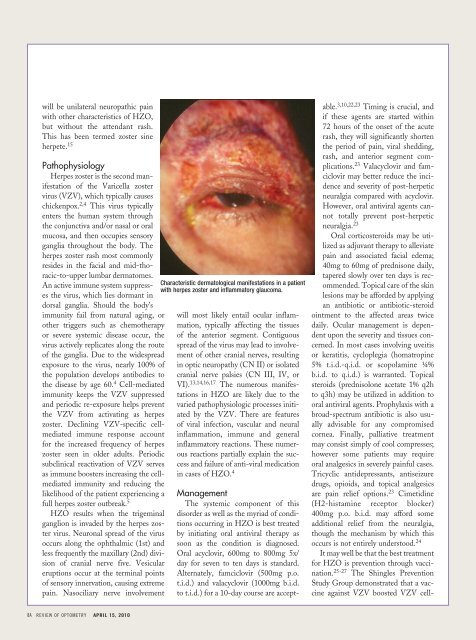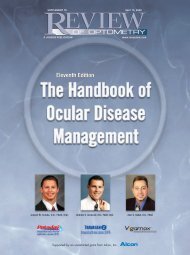Twelfth Edition - Review of Optometry
Twelfth Edition - Review of Optometry
Twelfth Edition - Review of Optometry
Create successful ePaper yourself
Turn your PDF publications into a flip-book with our unique Google optimized e-Paper software.
will be unilateral neuropathic pain<br />
with other characteristics <strong>of</strong> HZO,<br />
but without the attendant rash.<br />
This has been termed zoster sine<br />
herpete. 15<br />
Pathophysiology<br />
Herpes zoster is the second manifestation<br />
<strong>of</strong> the Varicella zoster<br />
virus (VZV), which typically causes<br />
chickenpox. 2,4 This virus typically<br />
enters the human system through<br />
the conjunctiva and/or nasal or oral<br />
mucosa, and then occupies sensory<br />
ganglia throughout the body. The<br />
herpes zoster rash most commonly<br />
resides in the facial and mid-thoracic-to-upper<br />
lumbar dermatomes.<br />
An active immune system suppresses<br />
the virus, which lies dormant in<br />
dorsal ganglia. Should the body’s<br />
immunity fail from natural aging, or<br />
other triggers such as chemotherapy<br />
or severe systemic disease occur, the<br />
virus actively replicates along the route<br />
<strong>of</strong> the ganglia. Due to the widespread<br />
exposure to the virus, nearly 100% <strong>of</strong><br />
the population develops antibodies to<br />
the disease by age 60. 4 Cell-mediated<br />
immunity keeps the VZV suppressed<br />
and periodic re-exposure helps prevent<br />
the VZV from activating as herpes<br />
zoster. Declining VZV-specific cellmediated<br />
immune response account<br />
for the increased frequency <strong>of</strong> herpes<br />
zoster seen in older adults. Periodic<br />
subclinical reactivation <strong>of</strong> VZV serves<br />
as immune boosters increasing the cellmediated<br />
immunity and reducing the<br />
likelihood <strong>of</strong> the patient experiencing a<br />
full herpes zoster outbreak. 5<br />
HZO results when the trigeminal<br />
ganglion is invaded by the herpes zoster<br />
virus. Neuronal spread <strong>of</strong> the virus<br />
occurs along the ophthalmic (1st) and<br />
less frequently the maxillary (2nd) division<br />
<strong>of</strong> cranial nerve five. Vesicular<br />
eruptions occur at the terminal points<br />
<strong>of</strong> sensory innervation, causing extreme<br />
pain. Nasociliary nerve involvement<br />
8A REVIEW OF OPTOMETRY APRIL 15, 2010<br />
Characteristic dermatological manifestations in a patient<br />
with herpes zoster and inflammatory glaucoma.<br />
will most likely entail ocular inflammation,<br />
typically affecting the tissues<br />
<strong>of</strong> the anterior segment. Contiguous<br />
spread <strong>of</strong> the virus may lead to involvement<br />
<strong>of</strong> other cranial nerves, resulting<br />
in optic neuropathy (CN II) or isolated<br />
cranial nerve palsies (CN III, IV, or<br />
VI). 13,14,16,17 The numerous manifestations<br />
in HZO are likely due to the<br />
varied pathophysiologic processes initiated<br />
by the VZV. There are features<br />
<strong>of</strong> viral infection, vascular and neural<br />
inflammation, immune and general<br />
inflammatory reactions. These numerous<br />
reactions partially explain the success<br />
and failure <strong>of</strong> anti-viral medication<br />
in cases <strong>of</strong> HZO. 4<br />
Management<br />
The systemic component <strong>of</strong> this<br />
disorder as well as the myriad <strong>of</strong> conditions<br />
occurring in HZO is best treated<br />
by initiating oral antiviral therapy as<br />
soon as the condition is diagnosed.<br />
Oral acyclovir, 600mg to 800mg 5x/<br />
day for seven to ten days is standard.<br />
Alternately, famciclovir (500mg p.o.<br />
t.i.d.) and valacyclovir (1000mg b.i.d.<br />
to t.i.d.) for a 10-day course are accept-<br />
able. 3,10,22,23 Timing is crucial, and<br />
if these agents are started within<br />
72 hours <strong>of</strong> the onset <strong>of</strong> the acute<br />
rash, they will significantly shorten<br />
the period <strong>of</strong> pain, viral shedding,<br />
rash, and anterior segment complications.<br />
23 Valacyclovir and famciclovir<br />
may better reduce the incidence<br />
and severity <strong>of</strong> post-herpetic<br />
neuralgia compared with acyclovir.<br />
However, oral antiviral agents cannot<br />
totally prevent post-herpetic<br />
neuralgia. 23<br />
Oral corticosteroids may be utilized<br />
as adjuvant therapy to alleviate<br />
pain and associated facial edema;<br />
40mg to 60mg <strong>of</strong> prednisone daily,<br />
tapered slowly over ten days is recommended.<br />
Topical care <strong>of</strong> the skin<br />
lesions may be afforded by applying<br />
an antibiotic or antibiotic-steroid<br />
ointment to the affected areas twice<br />
daily. Ocular management is dependent<br />
upon the severity and tissues concerned.<br />
In most cases involving uveitis<br />
or keratitis, cycloplegia (homatropine<br />
5% t.i.d.-q.i.d. or scopolamine ¼%<br />
b.i.d. to q.i.d.) is warranted. Topical<br />
steroids (prednisolone acetate 1% q2h<br />
to q3h) may be utilized in addition to<br />
oral antiviral agents. Prophylaxis with a<br />
broad-spectrum antibiotic is also usually<br />
advisable for any compromised<br />
cornea. Finally, palliative treatment<br />
may consist simply <strong>of</strong> cool compresses;<br />
however some patients may require<br />
oral analgesics in severely painful cases.<br />
Tricyclic antidepressants, antiseizure<br />
drugs, opioids, and topical analgesics<br />
are pain relief options. 23 Cimetidine<br />
(H2-histamine receptor blocker)<br />
400mg p.o. b.i.d. may afford some<br />
additional relief from the neuralgia,<br />
though the mechanism by which this<br />
occurs is not entirely understood. 24<br />
It may well be that the best treatment<br />
for HZO is prevention through vaccination.<br />
25-27 The Shingles Prevention<br />
Study Group demonstrated that a vaccine<br />
against VZV boosted VZV cell-





